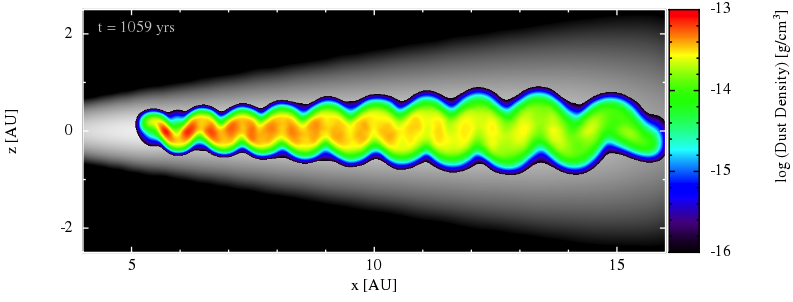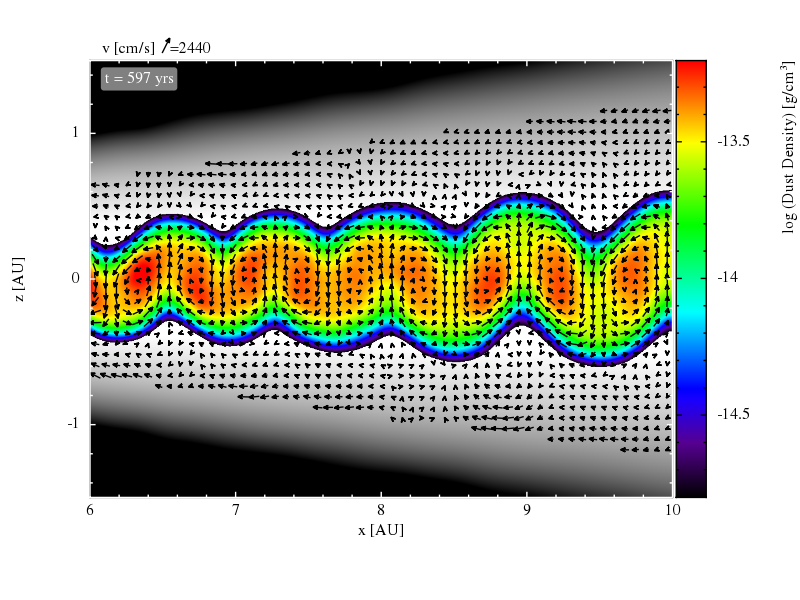Toridal vortices and the conglomeration of dust into rings in protoplanetary discsPablo Loren-Aguilar & Matthew R. Bate We identify a new hydrodynamical instability in protoplanetary discs that may arise due to variations in the dust-to-gas ratio and may lead to concentration of dust grains within a disc. The instability can arise due to dust settling, which produces a vertical compositional entropy gradient. The entropy gradient drives a baroclinic instability that is capable of creating toroidal gas vortices that gather dust into rings. Such dust rings are potentially observable via contin- uum emission of the dust or scattered light. Indeed, this instability may offer an explanation for the rings recently observed in the discs around the young stars HL Tau and TW Hya that do not rely on clearing by protoplanets. The instability may also have wider ramifications, potentially aiding dust agglomeration, altering the radial migration of larger planetesimals, and providing another mechanism for transporting angular momentum within a disc. The animations below show the development of the instability in a protoplanetary disc in which millimetre radii dust particles are initially distributed throughout the gas with a uniform dust-to-gas density rato of 0.01. The gas disc has a vertical scale height H/r=0.05. The animations show vertical slices through the disc, giving the azimuthally-averaged gas and dust densities. The dust settles towards midplane, but slows as it does so due to drag with the gas forming a dust layer that is thinner than the gas disc. An baroclinic instability then develops, first at small radii, and then spreading outwards through the disc in which toriodal vortices develop. These deform the dust layer so that it becomes corrugated, and at the same time gather the dust particles towards the centres of the vortices. Refereed Scientific Papers
"Toridal vortices and the conglomeration of dust into rings in protoplanetary discs" AnimationsSimulations & visualisations by Pablo Loren-Aguilar & Matthew Bate, University of Exeter unless stated otherwise. The movies below were produced using the SPLASH software written by Daniel Price to visualise SPH simulations (Price 2007). There are two animations. They both show azimuthally-averaged quantities in a vertical slice through the disc. The gas density is shown as a grey-scale, while the dust density is shown using a colour scale. The first animation shows the full radial extent of the dusty disc that was modelled, while the second animation shows a smaller radial range, and includes velocity vectors to clearly show the vortices. Dust settling and development of the instability: Full disc
Dust settling and development of the instability: Velocities
Copyright: The material on this page is the property of Matthew Bate. Movies and images are released under a Creative Commons Attribution-Noncommercial-Share Alike 3.0 License.
Notes on formats: Technical DetailsThe calculations model the protoplanetary disc orbiting a 1 solar mass star. The disc includes both gas and dust components. The gas disc locally vertically isothermal with a uniform scale height to radius ratio H/r=0.05 and a surface density profile that falls of as r-0.5. The gas disc extends from 2.6 to 16.1 AU, with a gas mass of 0.003 solar-masses. Self-gravity is neglected. Initially there is a uniform dust-to-gas density ratio of 0.01 between 5.2 and 15.6 AU. The dust taken to be composed of spherical grains with radii of 1 mm and densities of 3 g/cm3. The calculations were performed using a parallel three-dimensional smoothed particle hydrodynamics (SPH) code using 2 million particles for the gas, and 1 millon particles for the dust. The evolution of the dust/gas fluid was modelled using the SPH method of Loren-Aguilar & Bate (2014). The calculations were performed on STFC's DiRAC Complexity High Performance Computing facility, and the University of Exeter supercomputer. Copyright: Matthew Bate, University of Exeter.
|


